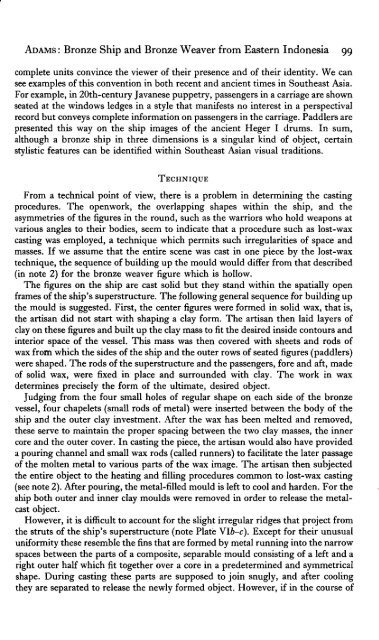A "Forgotten" Bronze Ship and a Recently ... - ScholarSpace
A "Forgotten" Bronze Ship and a Recently ... - ScholarSpace
A "Forgotten" Bronze Ship and a Recently ... - ScholarSpace
You also want an ePaper? Increase the reach of your titles
YUMPU automatically turns print PDFs into web optimized ePapers that Google loves.
ADAMS: <strong>Bronze</strong> <strong>Ship</strong> <strong>and</strong> <strong>Bronze</strong> Weaver from Eastern Indonesia 99<br />
complete units convince the viewer of their presence <strong>and</strong> of their identity. We can<br />
see examples of this convention in both recent <strong>and</strong> ancient times in Southeast Asia.<br />
For example, in 20th-century Javanese puppetry, passengers in a carriage are shown<br />
seated at the windows ledges in a style that manifests no interest in a perspectival<br />
record but conveys complete information on passengers in the carriage. Paddlers are<br />
presented this way on the ship images of the ancient Heger I drums. In sum,<br />
although a bronze ship in three dimensions is a singular kind of object, certain<br />
stylistic features can be identified within Southeast Asian visual traditions.<br />
TECHNIQUE<br />
From a technical point of view, there is a problem in determining the casting<br />
procedures. The openwork, the overlapping shapes within the ship, <strong>and</strong> the<br />
asymmetries of the figures in the round, such as the warriors who hold weapons at<br />
various angles to their bodies, seem to indicate that a procedure such as lost-wax<br />
casting was employed, a technique which permits such irregularities of space <strong>and</strong><br />
masses. If we assume that the entire scene was cast in one piece by the lost-wax<br />
technique, the sequence of building up the mould would differ from that described<br />
(in note 2) for the bronze weaver figure which is hollow.<br />
The figures on the ship are cast solid but they st<strong>and</strong> within the spatially open<br />
frames of the ship's superstructure. The following general sequence for building up<br />
the mould is suggested. First, the center figures were formed in solid wax, that is,<br />
the artisan did not start with shaping a clay form. The artisan then laid layers of<br />
clay on these figures <strong>and</strong> built up the clay mass to fit the desired inside contours <strong>and</strong><br />
interior space of the vessel. This mass was then covered with sheets <strong>and</strong> rods of<br />
wax from which the sides of the ship <strong>and</strong> the outer rows of seated figures (paddlers)<br />
were shaped. The rods of the superstructure <strong>and</strong> the passengers, fore <strong>and</strong> aft, made<br />
of solid wax, were fixed in place <strong>and</strong> surrounded with clay. The work in wax<br />
determines precisely the form of the ultimate, desired object.<br />
Judging from the four small holes of regular shape on each side of the bronze<br />
vessel, four chapelets (small rods of metal) were inserted between the body of the<br />
ship <strong>and</strong> the outer clay investment. After the wax has been melted <strong>and</strong> removed,<br />
these serve to maintain the proper spacing between the two clay masses, the inner<br />
core <strong>and</strong> the outer cover. In casting the piece, the artisan would also have provided<br />
a pouring channel <strong>and</strong> small wax rods (called runners) to facilitate the later passage<br />
of the molten metal to various parts of the wax image. The artisan then subjected<br />
the entire object to the heating <strong>and</strong> filling procedures common to lost-wax casting<br />
(see note 2). After pouring, the metal-filled mould is left to cool <strong>and</strong> harden. For the<br />
ship both outer <strong>and</strong> inner clay moulds were removed in order to release the metalcast<br />
object.<br />
However, it is difficult to account for the slight irregular ridges that project from<br />
the struts of the ship's superstructure (note Plate VIb-c). Except for their unusual<br />
uniformity these resemble the fins that are formed by metal running into the narrow<br />
spaces between the parts of a composite, separable mould consisting of a left <strong>and</strong> a<br />
right outer half which fit together over a core in a predetermined <strong>and</strong> symmetrical<br />
shape. During casting these parts are supposed to join snugly, <strong>and</strong> after cooling<br />
they are separated to release the newly formed object. However, if in the course of
















